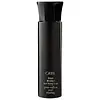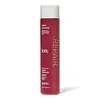What's inside
What's inside
 Key Ingredients
Key Ingredients

 Benefits
Benefits

 Concerns
Concerns

 Ingredients Side-by-side
Ingredients Side-by-side

Cyclopentasiloxane
EmollientIsododecane
EmollientPhenyl Trimethicone
Skin ConditioningBis-Hydroxyethoxypropyl Dimethicone
EmollientBis-Hydroxy/Methoxy Amodimethicone
Parfum
MaskingPolysilicone-15
UV FilterPPG-3 Benzyl Ether Myristate
EmollientSilicone Quaternium-22
PPG-3 Myristyl Ether
EmollientArgania Spinosa Kernel Oil
EmollientPersea Gratissima Oil
Skin ConditioningRosa Canina Fruit Oil
EmollientOryza Sativa Bran Extract
Skin ConditioningHelianthus Annuus Extract
EmollientRosmarinus Officinalis Leaf Extract
AntimicrobialTocopherol
AntioxidantPentaerythrityl Tetra-Di-T-Butyl Hydroxyhydrocinnamate
AntioxidantBenzyl Benzoate
AntimicrobialLimonene
PerfumingHexyl Cinnamal
PerfumingLinalool
PerfumingCitral
PerfumingCyclopentasiloxane, Isododecane, Phenyl Trimethicone, Bis-Hydroxyethoxypropyl Dimethicone, Bis-Hydroxy/Methoxy Amodimethicone, Parfum, Polysilicone-15, PPG-3 Benzyl Ether Myristate, Silicone Quaternium-22, PPG-3 Myristyl Ether, Argania Spinosa Kernel Oil, Persea Gratissima Oil, Rosa Canina Fruit Oil, Oryza Sativa Bran Extract, Helianthus Annuus Extract, Rosmarinus Officinalis Leaf Extract, Tocopherol, Pentaerythrityl Tetra-Di-T-Butyl Hydroxyhydrocinnamate, Benzyl Benzoate, Limonene, Hexyl Cinnamal, Linalool, Citral
Water
Skin ConditioningSodium Laureth Sulfate
CleansingCocamidopropyl Betaine
CleansingGlycol Distearate
EmollientPhenoxyethanol
PreservativeParfum
MaskingLaureth-4
EmulsifyingPolyquaternium-10
Sodium Chloride
MaskingSodium Benzoate
MaskingPolyquaternium-7
Ethylhexylglycerin
Skin ConditioningGuar Hydroxypropyltrimonium Chloride
Skin ConditioningLaureth-2
CleansingPEG/PPG-120/10 Trimethylolpropane Trioleate
Lactic Acid
BufferingLinalool
PerfumingDimethicone PEG-8 Meadowfoamate
EmollientTocopheryl Acetate
AntioxidantPanthenol
Skin ConditioningPropylene Glycol
HumectantHydrolyzed Quinoa
Skin ConditioningPotassium Sorbate
PreservativeWater, Sodium Laureth Sulfate, Cocamidopropyl Betaine, Glycol Distearate, Phenoxyethanol, Parfum, Laureth-4, Polyquaternium-10, Sodium Chloride, Sodium Benzoate, Polyquaternium-7, Ethylhexylglycerin, Guar Hydroxypropyltrimonium Chloride, Laureth-2, PEG/PPG-120/10 Trimethylolpropane Trioleate, Lactic Acid, Linalool, Dimethicone PEG-8 Meadowfoamate, Tocopheryl Acetate, Panthenol, Propylene Glycol, Hydrolyzed Quinoa, Potassium Sorbate
Ingredients Explained
These ingredients are found in both products.
Ingredients higher up in an ingredient list are typically present in a larger amount.
Linalool is a fragrance and helps add scent to products. It's derived from common plants such as cinnamon, mint, citrus, and lavender.
Like Limonene, this ingredient oxidizes when exposed to air. Oxidized linalool can cause allergies and skin sensitivity.
This ingredient has a scent that is floral, spicy tropical, and citrus-like.
Learn more about LinaloolParfum is a catch-all term for an ingredient or more that is used to give a scent to products.
Also called "fragrance", this ingredient can be a blend of hundreds of chemicals or plant oils. This means every product with "fragrance" or "parfum" in the ingredients list is a different mixture.
For instance, Habanolide is a proprietary trade name for a specific aroma chemical. When used as a fragrance ingredient in cosmetics, most aroma chemicals fall under the broad labeling category of “FRAGRANCE” or “PARFUM” according to EU and US regulations.
The term 'parfum' or 'fragrance' is not regulated in many countries. In many cases, it is up to the brand to define this term.
For instance, many brands choose to label themselves as "fragrance-free" because they are not using synthetic fragrances. However, their products may still contain ingredients such as essential oils that are considered a fragrance by INCI standards.
One example is Calendula flower extract. Calendula is an essential oil that still imparts a scent or 'fragrance'.
Depending on the blend, the ingredients in the mixture can cause allergies and sensitivities on the skin. Some ingredients that are known EU allergens include linalool and citronellol.
Parfum can also be used to mask or cover an unpleasant scent.
The bottom line is: not all fragrances/parfum/ingredients are created equally. If you are worried about fragrances, we recommend taking a closer look at an ingredient. And of course, we always recommend speaking with a professional.
Learn more about Parfum